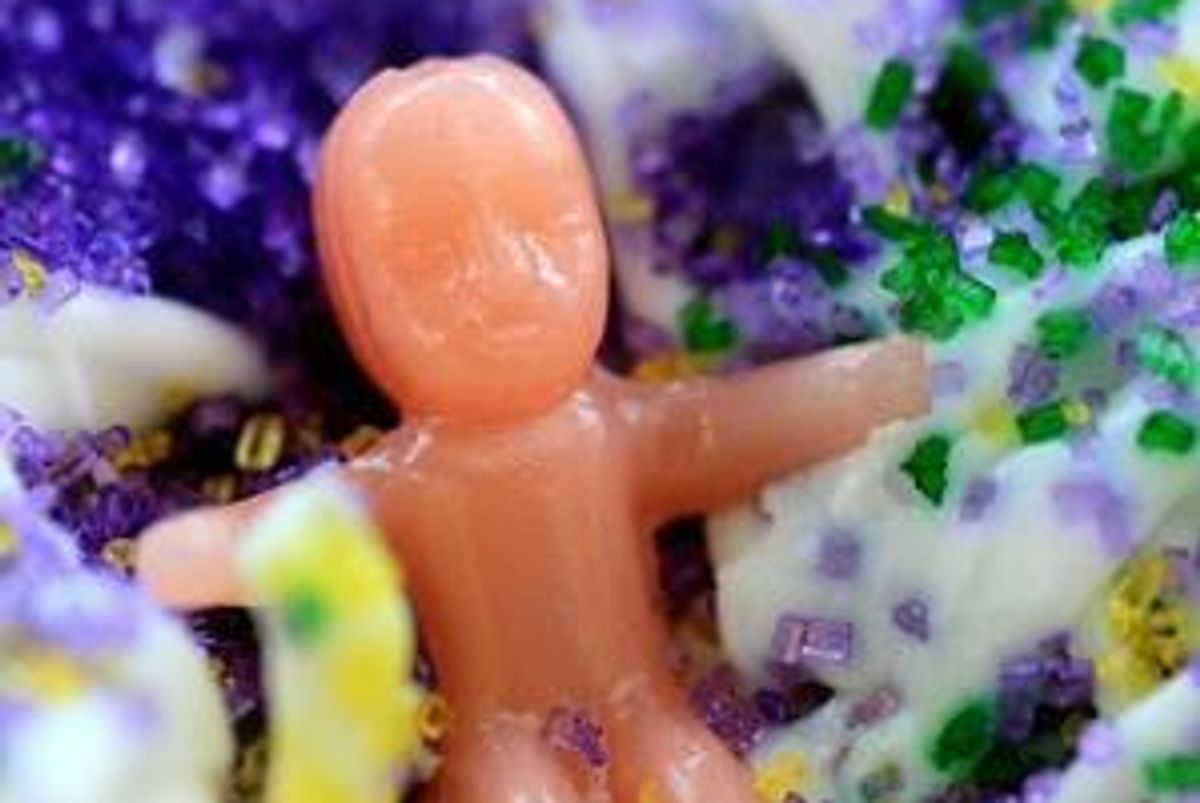You know, they didn't always put a plastic baby in a king cake. Here's why they did.

In my humble opinion, the Mardis Gras king cake is by far the coolest holiday dessert. It’s got a little bit of everything: a fun design, bold colors, a rich history (more on that later).
Made with yeasty cinnamon flavored dough—and heaps of symbolism—this regal pastry-cake hybrid is usually oval shaped to resemble a crown, along with tri-colored icing in gold, purple and green to represent power, justice and faith.
And let’s not forget the piece de resistance: that miniature plastic baby, destined to be found by one lucky individual. Lucky in the sense that finding it means they now have the honor of providing the cake for next year.
However, there wasn’t always a baby hiding in the dough. Like most traditions, this one has evolved and adapted over time. And, of course, it began with pagans.
Many historians believe that the king cake has much older origins, beginning with the Roman winter festival Saturnalia.
 File:Saturnalia by Antoine Callet.jpg - Wikimedia Commonscommons.wikimedia.org
File:Saturnalia by Antoine Callet.jpg - Wikimedia Commonscommons.wikimedia.orgDuring this winter solstice celebration, Saturn—the Roman god of agriculture—would be honored by using the gains of the season’s harvest to make ceremonial cakes. And instead of a miniature baby, one singular fava bean would be placed inside. And whosoever should find the bean would be named “king of the day.”
Which is a bit odd, considering in ancient tradition fava beans were regarded as omens of death. But other sources note that favas were considered magic and even used for voting. Certainly makes that infamous Hannibal line take on a whole new context.
In addition to baking, the festival would involve a raucous good time of booze, dancing, gambling and other, ahem, adult group activities.Fast forward to the rise of Christianity, the ritual adopted a more religious context in France.
 File:Edward Burne-Jones - The Adoration of the Magi - Google Art ...commons.wikimedia.org
File:Edward Burne-Jones - The Adoration of the Magi - Google Art ...commons.wikimedia.orgIn Roman Catholic tradition, the Epiphany denotes the day when the three kings first saw the baby Jesus. The king cake came to represent this day, even taking on the name of Epiphany cake.
So it stands to reason that if this sweet treat became associated with the celebration of baby Jesus, then of course the plastic baby was originally intended for such representation, right?
Wrong.
The baby wouldn’t make its appearance until the mid-1900s, and it was thanks to a clever salesman in New Orleans.
 File:Mobile Mardi Gras Carnival, 1900.jpg - Wikimedia Commonscommons.wikimedia.org
File:Mobile Mardi Gras Carnival, 1900.jpg - Wikimedia Commonscommons.wikimedia.orgBy then, the king cake had already been a prominent Mardi Gras item.
The owner of one of the 20th century’s most famous bakeries, Donald Entringer of McKenzie’s, was approached by a salesman carrying a surplus of tiny porcelain dolls from France, according to food expert Poppy Tooker in an interview with NPR.
"He had a big overrun on them, and so he said to Entringer, 'How about using these in a king cake,’” Tooker told NPR.
Though a simple case of supply-and-demand isn’t terribly exciting, the way this simple concept has advanced to become the dish’s golden standard is pretty remarkable.
Plus, the fact that this Louisiana tradition is steeped in history of bawdy hedonism and sacred spiritualism, all with a healthy dose of capitalizing on the combo … I mean if that’s not New Orleans in a nutshell, I don’t know what is.
It’s not just beans and babies either.
Pecans, jeweled rings, gold coins and small charms have also been used. Some bakeries have even made their own customized trinkets. Others have started avoiding placing them inside altogether, attempting to thwart potential lawsuits. Baking with plastic is a tad more frowned upon these days.
Though most of us are familiar with the NOLA style of the king cake, other countries have their own versions.
There’s the French galette des rois, which is less colorful but oh-so-flaky, topped with a golden paper crown.
Also there’s Spanish rosca de reyes, flavored with lots of orange and topped with dried fruit.
There’s even a Greek version, vasilopita, that’s very similar to coffee cake. Not that you couldn’t have any of these cakes for breakfast, but there’s an excuse baked right into this one.
No matter what style you try, or whether or not you find that plastic baby, the king cake—along with its festive history and captivating lore—is definitely worth celebrating.
- The weird, secret history of the electric car and why it disappeared ... ›
- A brief history of color photography reveals an obvious but unsettling ... ›
- These bread revolts changed history. We should know why ... ›
- 2 awesome strangers brought gifts for a newborn baby after receiving a misdirected text - Upworthy ›

